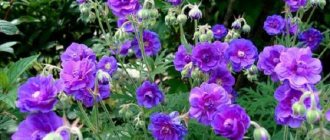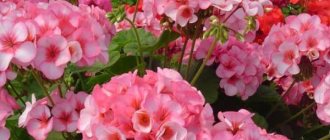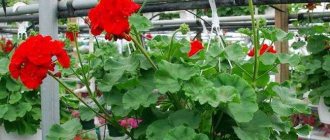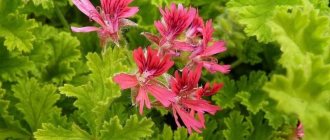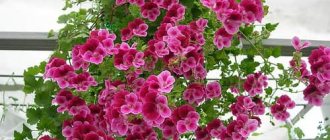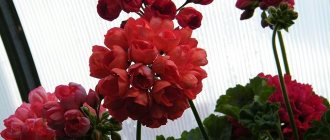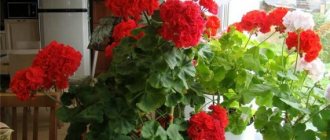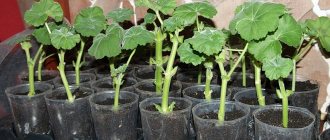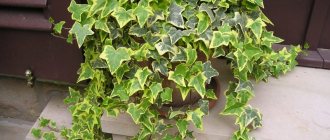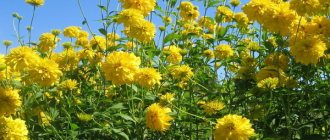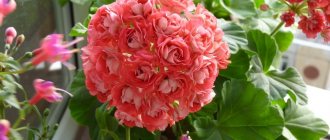Zonal pelargonium is an incredibly popular plant, which, just 20-30 years ago, could be found on almost every windowsill. The plant has high decorative qualities and is easily propagated at home by sowing seeds and cuttings. Even a novice gardener can grow it. It has antiseptic properties and releases phytoncides, which have a detrimental effect on harmful bacteria and microorganisms. Essential oil is used in perfumery to flavor gels, soaps and eau de toilette. But not everyone likes the specific smell of the leaves of this plant.
Spectacular indoor plant
Pelargonium zonalis (its other name is bordered) has erect thick shoots 30-80 centimeters in height, the leaves are pubescent. With sufficient lighting, they have dark and light circles of varying shades: from emerald-golden to dark brown. The plant blooms profusely and for a long time at home: from spring until the first frost, the flowers last a very long time and do not fall off. Inflorescences are umbrellas with simple or double flowers of various colors. The varieties of rosebud zonal pelargoniums look especially impressive; their flowers are shaped like small roses.
Caring for zonal pelargonium
Usually the plant does not cause any trouble; caring for it at home is very simple. Pelargonium needs bright lighting and tolerates even direct sunlight, so it is better to place it on southern windowsills. With long daylight hours, it also does well on the north side, but does not bloom as profusely. In the autumn-winter period, it is still better to choose a brighter place for it, otherwise the shoots will stretch out.
Pelargonium needs an influx of fresh air, so it feels great on balconies. The ideal temperature for growing in summer is 25-30 degrees. In the winter months, caring for the plant involves maintaining the temperature no higher than 14 degrees, this will ensure abundant and long-lasting flowering. Pelargonium is able to accumulate water in its fleshy shoots. Therefore, in summer there is no need to water it immediately after the top layers of the soil dry out; you should wait three to four days. With the onset of cold weather, water very sparingly, preventing the soil from drying out. Low temperatures and high humidity can cause the roots to rot and the plant will die. It tolerates dry air well and does not need spraying.
Popular indoor flower
Caring for the plant at home includes the correct addition of additional nutrients. Pelargonium zonalis does not like excess fertilizers; it does not absorb organic fertilizers well. Fertilizing is applied no earlier than two months after transplantation, and phosphorus fertilizer is used for this. During the entire period of active growth - from spring to the end of summer, care does not require much effort; it will be enough to feed the plant two or three times. Such simple care will ensure luxurious flowering for several months, the formation of beautiful bushes, and with additional pollination, the ripening of seeds.
Secrets of keeping geraniums
Pests and diseases
Pelargonium may show signs of damage by the following insects:
- spider mites,
- mealybug,
- aphids,
- thrips.
If a lesion is detected, it is necessary to treat the affected plant with insecticides.
Most often, the plant is affected by whitefly . She lays her larvae on the back of the leaf.
You can overcome it with soapy water. The bush must be treated with soapy water and covered with polyethylene for several days.
In case of severe damage, treat with special chemical preparations.
The plant may be affected by a dangerous disease - black leg , most often this is due to excessive watering and incorrect temperature conditions.
If you notice a gray coating on the leaves of the plant, and they become yellow with brown spots, it is likely that the plant is affected by mold . It is important to destroy the affected leaves and treat the plant with fungicides.
As you can see, growing zonal pelargonium is quite easy and even a novice gardener can do it, since it is quite unpretentious to the conditions of its maintenance, but at the same time it will delight you for a long time with its fluffy and beautiful flowering at home, on the balcony or at your dacha.
Pruning and replanting pelargonium
Pelargonium, depending on the variety, can have compact bushes or grow to enormous sizes at home. Therefore, to maintain a decorative appearance and abundant flowering, the plant must be pruned annually. This is done in two stages:
- The first pruning is carried out in the fall after flowering has stopped. Only ½ of the height of the shoots is left. They do this to ensure good air exchange and reduce the risk of fungal infections. If the stems further dry out or change color at the cut points, they are shortened.
- At the end of February, when the daylight hours become longer and the plant begins to grow, they prune again and form a bush, leaving stems with 3 to 4 nodes. The plant is capable of laying flower buds very quickly, so this procedure will not harm it in any way.
Replanting geraniums
In addition, during the entire growth period, you can pinch the shoots to maintain a highly decorative appearance. Pruning is done with a very sharp knife or blade, which is first wiped with alcohol. The cut is made at an acute angle, without touching the growth point. To avoid infection, all sections are treated with crushed coal, cinnamon, brilliant green or garden pitch.
Caring for young specimens at home involves annual transplants into larger flowerpots. Adults move after the roots completely occupy the entire pot. The container should not be too large, otherwise the plant will bloom poorly. The bottom of the pot is covered with drainage, then filled with soil. As a substrate, take leaf, turf soil, sand and humus in a ratio of 2:2:2:1.
What is it - botanical characteristics and history of occurrence
Geranium is native to South Africa. In the 16th century it was brought to Europe. But since the flower was not adapted to the local climate, breeders made efforts to adapt it. After which the plant became very popular. It appeared in Russia in the 18th century.
Reference. Zonal geranium is a vertically growing bush with fluffy foliage. At its top, the flowers are collected in large inflorescences in the form of a ball. They mainly come in white, red and pink colors, depending on the variety.
Geranium flowers and leaves have a characteristic odor. Although the plant is perennial, it needs to be renewed. Over time, the lower leaves fall off, the stems become bare, and the appearance deteriorates. Geranium zonalis grows quickly. It can grow up to 30 cm in a year. With proper care and comfortable conditions, the plant blooms throughout the year.
Propagation of zonal pelargonium by cuttings
One of the advantages of zonal pelargonium is its easy propagation at home. There are two ways to do this:
- cuttings;
- growing from seeds.
Pelargoniums can be propagated at any time of the year, but the best months for this are July, and in the spring - March and April. Growing a flower from cuttings taken in summer produces stronger and healthier bushes. For this purpose, cut off the upper part of the stem with 4-5 leaves and air-dry for several hours. For faster root formation, sections can be treated with stimulants. As a substrate, mix turf soil, peat and sand (1:1:1). If there are a lot of cuttings, then they are planted in a container, and when the plants take root and begin to grow, they are placed in individual pots.
Decorative flower propagation
The container is placed on the windowsill, providing bright, diffused lighting. The soil is sprayed with a spray bottle, avoiding waterlogging. If you provide proper care for the seedlings, zonal pelargonium begins to grow roots within two weeks. And after another six months it will delight you with its lush flowering. To form a lush bush, a rooted seedling can be lightly pinched. In addition, the plant can be successfully rooted at home “the old fashioned way” in water.
Popular varieties: description and photo
Below you can read the description of geranium varieties and see photos. One of the popular varieties of zonal geranium is Rafaella. The bush of this beautiful plant:
- compact;
- well branched;
- thick;
- strong;
- dense.
The flowers of the Rafaella geranium variety have different colors. Thanks to this, everyone can choose a flower that suits them according to the color of the buds.
Attention! This hybrid is easy to grow from seeds. It can grow indoors as well as in the garden.
The plant is resistant to heat and short-term drops in temperature.
An excellent variety of zonal geranium is Chandelier Mix. This perennial plant has large flowers collected in ball-shaped inflorescences that have a variety of shades. The leaves are round. Chandelier Mix loves sunny places and loose, fertile soil.
White zonal geranium is a low plant, growing up to 30 cm in height. This delightful and delicate flower grows well both in a flower bed and in a pot at home.
Another popular variety is zonal geranium Meteor. It has bright dark green leaves; the zoning zone on them is almost impossible to distinguish. The flowers are painted a rich red color with dark longitudinal stripes. This variety is perfect for growing in the garden.
Seed propagation
Proper care, creation of favorable conditions and pollination of flowers contribute to the ripening of a large number of seeds in pelargonium in summer - early autumn. They are used for further reproduction. They are quite large and have high germination rates. Growing zonal pelargonium from seeds at home can be done at any time of the year, provided good lighting is maintained.
For sowing seeds, loose and breathable soil is used. Its composition can include perlite, vermiculite, sand, humus. Ideal for germination is a mixture of turf soil (2 parts), sand (1 part) and peat (1 part). Due to the vulnerability of young seedlings to fungal diseases, it is advisable to disinfect the soil with a pink solution of potassium permanganate or any other suitable fungicide.
To plant seeds, use containers or boxes that are filled with moist soil mixture. Seedling is done to a depth of 2-5 mm, then sprayed and covered with transparent film or glass. In order to avoid the appearance of mold and rotting of seedlings, the greenhouse is ventilated daily.
Plant seeds
The ideal temperature for germination at home is 18-22 degrees. From the moment the seeds are planted until the flowers appear, an average of 5-6 months pass. Caring for seedlings involves maintaining good diffuse lighting and protection from direct sunlight. Young pelargoniums are picked into separate pots after the formation of at least three true leaves. Pelargonium grown from seeds has a more compact and decorative appearance compared to specimens obtained by cuttings.
How to improve the flowering of exquisite geraniums?
Varieties of geranium
Pelargoniums are unique when it comes to their classification. They can be annual, perennial garden or houseplants. Many geraniums make excellent landscape cover, which designers love to take advantage of.
Zonal pelargonium
Zoned geranium, or regular and saran geranium, gets its name from the colored stripes present in zones on the leaves. Zonal pelargoniums include hundreds of cultivars, each of which produces single or double flowers in ball-shaped clusters during the growing season. Colors include orange, red, salmon, pink, white and lavender. One plant blooms several balls at a time. They grow in a round, upright form and thrive in gardens, mixed beds and containers. Some varieties of zonal geranium produce lacy leaves or leaves with white edges and variegated patterns.
Royal flower
Royal geraniums produce the largest flowers of all types. Bicolor flowers have a dark colored center that fades into a second color, usually white. Color combinations include purple and lavender, pink and white, purple and pink, and crimson and red. Royal geranium prefers cold weather. It blooms in spring and late summer when night temperatures remain low.
Ivy-leaved species
They are best suited for hanging baskets and window boxes where their stems are free to bloom in all their glory. Geranium ivy produces thick, glossy leaves that resemble ivy. Unlike other species, ivy requires constantly moist soil, especially when temperatures rise above 30 degrees.
Aromatic option
Cultivated for their fragrant foliage, they produce the smallest flowers of any species. They have changed little over time. Depending on the specific variety, the leaves may smell like mint, rose, chocolate, various spices, lemon and other citrus fruits. The shapes of these plants vary depending on their scent, and the leaves can be lacy, jagged, rounded or sparkling. Geraniums with aromatic leaves grow well in containers and in the front porch garden, where their attractive textures and vibrant scents are a delight.
What it is?
Zonal geranium is a very lush perennial subshrub with a straight stem, which is densely covered with green, rounded, jagged leaves; they are attached to the trunk with a long petiole. The height can reach up to a meter.
Along the edges of the sheet there are brown or dark green edgings in the form of circles, zones painted in a different color stand out, which is why the name “zonal” comes from it.
At the top of the stem, on long peduncles, there are flowers of various colors, collected in spherical inflorescences or in umbrellas. When you press the stems and leaves, a peculiar tart aroma comes out , since the plant contains healing essential oils.
